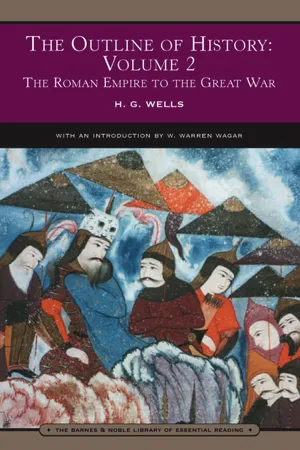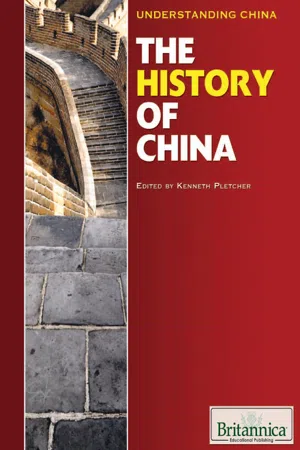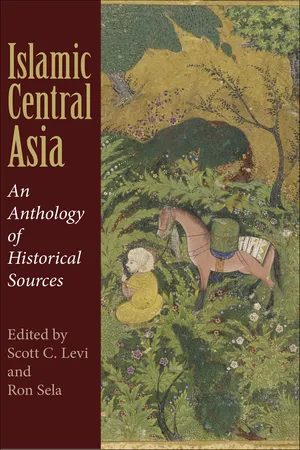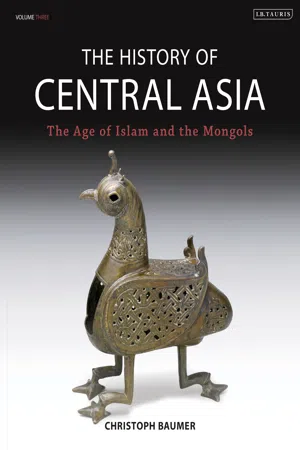History
The Mongol Empire
The Mongol Empire, established by Genghis Khan in the 13th century, was the largest contiguous land empire in history. It stretched from Eastern Europe to the Sea of Japan and was known for its military conquests, trade networks, and cultural exchange. The empire's legacy includes the spread of technologies, ideas, and the unification of diverse peoples under a single rule.
Written by Perlego with AI-assistance
Related key terms
10 Key excerpts on "The Mongol Empire"
- eBook - ePub
- Timothy May(Author)
- 2007(Publication Date)
- Pen & Sword Military(Publisher)
Chapter One The rise and expansion of The Mongol Empire, 1185–1265The Mongol Empire founded by Chinggis Khan (also known as Genghis Khan in the West) became the largest contiguous empire in history, stretching from the Sea of Japan to the Mediterranean Sea and the Carpathian Mountains. At its peak, more than a million men were under arms and enrolled in the armies of the Khan, or the emperor of The Mongol Empire. The Mongol Khans became determined to conquer the world, and, indeed, with the resources at their disposal there was little reason why they should fail. Eventually, however, their empire collapsed, partially under its own weight. The following is a brief history of the rise of The Mongol Empire and its subsequent expansion across Asia and into Europe, until it fragmented into four smaller yet still powerful kingdoms.The rise of Chinggis KhanThe most difficult stage in the evolution of The Mongol Empire was the unification of Mongolia itself under Chinggis Khan. There was no clear reason why Temüjin, as Chinggis Khan was known, should become the supreme power in the Mongolian steppe. Indeed, there were many more significant leaders and tribes. The Mongols themselves were a broken power, having suffered defeats by their hereditary enemies – the Tatars in eastern Mongolia, and the Jin Dynasty, which ruled Northern China – in the 1160s. The ramifications of these defeats were immense, and resulted in the Mongols declining to the status of a minor power in the steppe, often requiring the support of more powerful tribes to withstand the continued aggression of the Tatars. Nonetheless, although the Mongols were now without a true khan a few clan leaders still maintained the struggle. One such leader was Yisügei Bahadur (bahadur - eBook - ePub
- Paul Strathern(Author)
- 2020(Publication Date)
- Pegasus Books(Publisher)
4 The Mongol EmpireJust as the Huns, the Goths and the Vandals had driven all before them some eight centuries previously, so would the Mongols prove an irresistible force as they spread out from their homeland across the Eurasian land mass.In migrant tribes of hunter-gatherers, living off the land through which they passed, every man was a warrior. Such migrations could support roaming bands of a few hundred people at most. The next stage of human development involved shepherds. In such societies too, every man was a warrior; but as the warriors brought their sustenance with them in herds, they could move in larger groups. This was how Muhammad could gather 10,000 men for his march on Mecca.The third stage of development involved settled pastoral people. Such societies were more sophisticated. The surplus of their produce could support leisure and culture – as well as a standing army. Yet ironically, these cultured societies were no match for the migrations of what were essentially barbarian tribesmen, as the Romans discovered. And now, almost a millennium later, the peoples of the Eastern and the Western worlds would be forced to learn this lesson anew – as the Mongol hordes poured out from their eastern fastness across two continents.15No great empire is fundamentally unique – but The Mongol Empire would contain sufficient anomalies to set it apart from almost all other empires, both before and since, great and small. Its history, even its very existence, is beset with contradictions. This would be the largest contiguous land empire the world has ever seen, stretching from the Pacific to the eastern borders of Germany, yet it would prove the most short-lived great empire in history. It would be an empire that tolerated all religions – from Islam to Christianity and Buddhism, from Shamanism to Judaism and Taoism. Yet it would also forbid many of these religions from carrying out their most sacred practices. - eBook - ePub
Mongolian Nomadic Society
A Reconstruction of the 'Medieval' History of Mongolia
- Bat-Ochir Bold(Author)
- 2013(Publication Date)
- Routledge(Publisher)
The history of Mongolia from the twelfth to the eighteenth centuries represents a period which has long been of interest to specialists of Mongolian studies and which has been extensively researched. This does not mean, however, that historians have been able to reach a common opinion concerning this period. There are still a great many of unexplained questions that arise not so much from the scanty empirical material available as from the differing criteria of evaluation. An analysis of these differing means of evaluation is a prerequisite for an exact understanding of the character of the course of Mongolian history. In describing a feature of history, the historian is of course guided by his own objectives. The various viewpoints for the description of the period of the twelfth to the eighteenth centuries in Mongolia are further influenced by two factors. The first is spatial: when a people leaves deep tracks in the history of another people, the formers development must be taken into account in the historiography of the latter. The second factor is temporal: with the emergence of a new politico-historical phase of a people, the way of viewing historical phenomena often changes. On account of these factors the dynamics of this period of Mongolian history is complicated and multi-layered, and it is precisely this which will be the subject of our research.One of the main causes of the plurality of opinions concerning this period, and in general of the interest in Mongolian history, is the fact that at the start of the thirteenth century there arose a unified, independent Mongolian Empire which had a great influence not only on the further course of Mongolian history but also on the history of other peoples.The Mongolian Empire of the thirteenth and fourteenth centuries was vast – it extended from what is today Korea to Hungary, encompassed the entire Asian continent up to India, Southeast Asia and Eastern Europe. It existed in this size for more than a hundred years and in some regions for even longer as partial or successor empire. The main difference between the Mongols and earlier conquerors is that no other previous nomad empire has controlled the Asian inner steppe and vast regions of settled peoples.From the viewpoint of the historian, this had a significant consequence: the history of the Mongolian Empire was considerably better documented than its predecessors. The reason for this is that the settled peoples wrote about the Mongols as part of their own history. Research into the Mongolian Empire has therefore a special character. A complex problem arises from the number of sources – in Mongolian, Chinese, Persian, Arabic, Russian, French, Latin, Turkish, Japanese, Armenian, Georgian, Tibetan and other languages. No single person is able to read more than a fraction of the available sources in the original. In addition to this there is also the cultural problem. The medieval systems in China, in the Islamic countries, in Europe and amongst the nomadic peoples differ from one another considerably. Historical accounts have therefore differing traditional starting points, backgrounds and objectives and are marked by differing mentalities. - eBook - ePub
- Dr. Christopher Gabel(Author)
- 2014(Publication Date)
- Tannenberg Publishing(Publisher)
{22} Another issue that hinders the study of the Mongols is the state of Mongol cultural development compared to the subjected peoples’ cultural development.Unlike the Persians, Greeks, Romans and Chinese, who forcibly stamped their culture on conquered peoples, the Mongols overtime absorbed the culture of their more developed subjects. The Mongols’ military was far more advanced than the sedentary cultures they conquered, but once in control the Mongols often relied upon the administrative machinery of the of the defeated peoples to manage those regions. This left it to those conquered peoples to characterize the Mongols, and while in awe of Mongol military prowess, they were often less kind in describing their conquerors’ culture and society. As a nomadic people, the Mongols did not have large urban areas, or a capital complex or governing bureaucracy to aid in governance of the ever-expanding empire. With no capital and no bureaucracy, and the vast majority of Mongols being illiterate, Genghis Khan had no choice but to rely upon the literate members of foreign bureaucracies to staff and document his growing empire. Furthermore, the nomadic peoples of inner Asia were long tempted by the riches of their sedentary neighbors. This was no different with the Mongols who, now controlling those riches, succumbed to them. So it is accurate to say that while the Mongols militarily conquered many sophisticated nations, those same nations culturally conquered the Mongols over time.{23} This makes studying the Mongols a challenge for any scholar, and part of the reason that so much of Genghis Khan’s life is shrouded in myth and legend.Figure 2. Genghis Khan portrait cropped from a page in an album depicting several Yuan emperors at the National Palace Museum in Taipei; 14th Century; author unknown - eBook - ePub
The Outline of History: Volume 2 (Barnes & Noble Library of Essential Reading)
The Roman Empire to the Great War
- H. G. Wells(Author)
- 2009(Publication Date)
- Barnes & Noble(Publisher)
We have already mentioned the very recent Kharismian empire of Turkestan, Persia, and North India. This empire extended eastward to Kashgar, and it must have seemed one of the most progressive and hopeful empires of the time. Jengis Khan, while still engaged in this war with the Kin empire, sent envoys to Kharismia. They were put to death, an almost incredible stupidity. The Kharismian government, to use the political jargon of today, had decided not to “recognize” Jengis Khan, and took this spirited course with him. Thereupon (1218) the great host of horsemen that Jengis Khan had consolidated and disciplined swept over the Pamirs and down into Turkestan. It was well armed, and probably it had some guns and gunpowder for siege work—for the Chinese were certainly using gunpowder at this time, and the Mongols learnt its use from them. Kashgar, Khokand, Bokhara fell and then Samarkand, the capital of the Kharismian empire. Thereafter nothing held the Mongols in the Kharismian territories. They swept westward to the Caspian, and southward as far as Lahore. To the north of the Caspian a Mongol army encountered a Russian force from Kieff. There was a series of battles, in which the Russian armies were finally defeated and the Grand Duke of Kieff taken prisoner. So it was the Mongols appeared on the northern shores of the Black Sea. A panic swept Constantinople, which set itself to reconstruct its fortifications. Meanwhile other armies were engaged in the conquest of the empire of the Hsia in China. This was annexed, and only the southern part of the Kin empire remained unsubdued. In 1227 Jengis Khan died in the midst of a career of triumph. His empire reached already from the Pacific to the Dnieper. And it was an empire still vigorously expanding.Like all the empires founded by nomads, it was, to begin with, purely a military and administrative empire, a framework rather than a rule. It centred on the personality of the monarch, and its relations with the mass of the populations over which it ruled was simply one of taxation for the maintenance of the horde. But Jengis Khan had called to his aid a very able and experienced administrator of the Kin empire, who was learned in all the traditions and science of the Chinese. This statesman, Yeliu Chutsai, was able to carry on the affairs of the Mongols long after the death of Jengis Khan, and there can be little doubt that he is one of the great political heroes of history. He tempered the barbaric ferocity of his masters, and saved innumerable cities and works of art from destruction. He collected archives and inscriptions, and when he was accused of corruption, his sole wealth was found to consist of documents and a few musical instruments. To him perhaps quite as much as to Jengis is the efficiency of the Mongol military machine to be ascribed. Under Jengis, we may note further, we find the completest religious toleration established across the entire breadth of Asia. - eBook - ePub
- Britannica Educational Publishing, Kenneth Pletcher(Authors)
- 2010(Publication Date)
- Britannica Educational Publishing(Publisher)
The Mongol armies started their attack in 1211, invading from the north in three groups; Genghis Khan led the centre group himself. For several years they pillaged the country; finally, in 1214 they concentrated on the central capital of the Jin, Zhongdu (present-day Beijing). Its fortifications proved difficult to overcome, so the Mongols concluded a peace and withdrew. Shortly afterward the Jin emperor moved to the southern capital at Bianjing (present-day Kaifeng). Genghis Khan considered this a breach of the armistice, and his renewed attack brought large parts of northern China under Mongol control and finally resulted in 1215 in the capture of Zhongdu (renamed Dadu in 1272). The Mongols had had little or no experience in siege craft and warfare in densely populated areas; their strength had been chiefly in cavalry attacks. The assistance of defectors from the Jin state probably contributed to this early Mongol success. In subsequent campaigns the Mongols relied even more on the sophisticated skills and strategies of the increased number of Chinese under their control.GENGHIS KHANGenghis, or Chinggis, Khan (original name Temüjin; b. 1162—d. 1227) was the great Mongolian warrior-ruler of the late 12th and early 13th centuries. Under his leadership, the Mongols consolidated nomadic tribes into a unified Mongolia and fought from China’s Pacific coast to Europe’s Adriatic Sea, creating the basis for one of the greatest continental empires of all time. The leader of a destitute clan, Temüjin fought various rival clans and formed a Mongol confederacy, which in 1206 acknowledged him as Genghis Khan (“Universal Ruler”). By that year the united Mongols were ready to move out beyond the steppe. He adapted his method of warfare, moving from depending solely on cavalry to using sieges, catapults, ladders, and other equipment and techniques suitable for the capture and destruction of cities. In less than 10 years he took over most of Juchen-controlled China; he then destroyed the Muslim Khwā rezm-Shah dynasty while his generals raided Iran and Russia. He is infamous for slaughtering the entire populations of cities and destroying fields and irrigation systems but admired for his military brilliance and ability to learn. He died on a military campaign, and the empire was divided among his sons and grandsons.The Mongol conqueror Genghis Khan on his deathbed, surrounded by his four sons . Hulton Archive/Getty ImagesAfter 1215 the Jin were reduced to a small buffer state between the Mongols in the north and Song China in the south, and their extinction was but a matter of time. The Mongol campaigns against Xi Xia in 1226–27 and the death of Genghis Khan in 1227 brought a brief respite for Jin, but the Mongols resumed their attacks in 1230. - eBook - ePub
Islamic Central Asia
An Anthology of Historical Sources
- Scott C. Levi, Ron Sela(Authors)
- 2009(Publication Date)
- Indiana University Press(Publisher)
Part 3
The Mongol Empire
Passage contains an image
INTRODUCTION
The Mongol conqueror Chinggis Khan (more well known as Genghis Khan) was named Temujin when, probably in 1167, he was born in the pastoral-nomadic steppe to the north of China. When Temujin was just nine years old, a band of Tatars poisoned his father, Yisugei, and the remaining years of Temujin’s adolescence were extremely difficult. Shunned and alone, his mother, Ho’elun, managed to care for her children and keep them alive, although at times it seemed she was destined to fail. Being raised in such an environment taught Temujin the importance of strength, self-reliance, and persistence. In later years he also proved himself to be an insightful judge of character, a charismatic and visionary leader, a brilliant military strategist, and a ruthless conqueror.In the early years of the thirteenth century, Temujin managed to attract a substantial following and establish himself as the dominant power in the steppe north of China. In 1206, the defeated nomadic tribal aristocracy was gathered together so that they might acclaim Temujin to be “Chinggis Khan”: the Oceanic Ruler. They did so, and soon thereafter the Mongol armies erupted with the full might of the steppe. China was the first to experience the Mongol onslaught. Moving southwestward, in 1209 the Mongols forced the small Tibetan-Buddhist Hsi Hsia kingdom to acknowledge their suzerainty. Chinggis Khan then turned his attention to the considerably more substantial and potentially disruptive power to the east, the ethnically Manchurian Qin (1125–1234). The Qin themselves had just one century earlier departed the steppe to invade the Khitan territories in northeastern China, conquering some and forcing others to move westward where they became known as the Qara Khitai. In 1215, the invading Mongol army occupied the Qin capital of Zhongdu, modern Beijing, and forced the Qin to retreat and take up a defensive position further to the south. Soon thereafter, the Qin received a temporary reprieve as events in Central Asia drew the Mongol forces from their campaigns in China. - eBook - ePub
The History of Central Asia
The Age of Islam and the Mongols
- Christoph Baumer(Author)
- 2016(Publication Date)
- I.B. Tauris(Publisher)
VII The United Mongol Empire ‘You can conquer an empire on horseback but you cannot rule it from horseback.’ Alleged admonition of YELÜ CHUCAI (1189–1243) to Khan Ögödei. 1 1. Great Khan Ögödei and the Construction of Karakorum Genghis Khan is considered to have been the founder of the Mongol nation, but it was Ögödei (r. 1229–41), his third son, who established the Mongol state. But even though it is generally accepted that Ögödei had been designated crown prince in 1219, 2 it was Genghis Khan’s fourth son Tolui (r. as regent 1227–29) who took over military command on his father’s death, and for two years managed government affairs. Rashid al-Din reports: ‘Tolui Khan mounted the imperial throne in the home yurt, where Genghis Khan’s throne and his great ordus were. Most of the time he was in attendance upon Ögödei Qa’an, and he played an important role in his enthronement as qa’an.’ 3 Tolui controlled an army of 101,000 Mongol warriors, but he did not dare to declare himself Great Khan. He exercised a considerable influence over the army, but conceded to Ögödei the title of Great Khan and the administration of the conquered territories. When Tolui died in 1233, probably poisoned, his widow Sorkaktani Beki steadfastly refused to marry Ögödei’s son Güyük, for this would have placed the army under the direct control of the Great Khan. 4 Ögödei faced a very difficult task: on the one hand the ruling family regarded the conquered territories as their own possessions, but on the other the future empire was already threatened with fragmentation and clearly could not be administered without a central governing structure. Ögödei attempted to square the circle by linking together the two existing models of governance: the traditional rule of the steppe by the dominant clan and the administrative structures of sedentary states - eBook - ePub
The Indian Frontier
Horse and Warband in the Making of Empires
- Jos Gommans(Author)
- 2017(Publication Date)
- Routledge(Publisher)
Slightly earlier, from the sixth century onward, in regions in or immediately bordering on the Eurasian Arid Zone, the earlier development towards ever heavier cavalry was halted by the sudden emergence of two new incredibly powerful nomadic powers: the Arabs in the Middle East and the Turks in Central Eurasia. Due to the sheer number and quality of the Central Eurasian horse, it was in particular the Turks who were able to dominate military practice in a vast area that stretched from the Hungarian plain to the Great Wall of China in the northern steppes zone, and from Egypt to southern India in the southern desert zone. By far the most prominent ethnic group among them was the Qipchaq Turks who, in the thirteenth century, provided state-of-the-art horse warriors, and even rulers, to states as far apart as the Kingdom of Hungary, the Mamluk Sultanate in Egypt, and the Delhi Sultanate in India. Much later, the most powerful of the post-nomadic empires, the Ottomans and the Mughals, continued this already rich tradition of Turkish empire-building, and even the Iranian but heavily Turkified dynasty of the Safavids could only follow in the footsteps of their Seljuq (eleventh-twelfth centuries), Qara Quyunlu and Aq Quyunlu (fourteenth-fifteenth centuries) predecessors and build their power on the Turkish man- and horsepower found in their northern territories. In all these cases, Turkification automatically implied militarization, and a growing tendency towards Turkish or Turkified rulers across the whole Eurasian continent, who conspicuously demonstrated their outstanding martial qualities, be it in actual practice on the battlefield or imagined in sumptuous rituals, heroic poetry or austere architecture. In Northeast Asia, the machismo of the Turks finds an almost perfect parallel in the military prowess of the Mongolian Khitans and Tungunsic Jurchens who provided the horsepower and dynasties for, respectively, the Liao and the Qara Khitai, and the Jin and Qing empires.However, the absolute highpoint of Central Eurasian power was not a Turkish but a Mongol achievement: the unprecedented thirteenth-century expansion of the nomadic empire under the brilliant leadership of Temüjin, better known as Chinggis Khan. But was there really that much difference between Mongol and Turkish expansion? Our use of the contraction ‘Turko-Mongol’ is partly informed by the contemporary Arabic and Persian sources which repeatedly convey the belief that Mongols and Turks belonged to one and the same race. For example, the historian Rashid al-Din (12471318), who was very close to the scene, stressed very much unity in diversity: - Peter Jackson(Author)
- 2023(Publication Date)
- Routledge(Publisher)
I THE DISSOLUTION OF The Mongol EmpireIn 1251 a three years’ interregnum in the headship of The Mongol Empire was terminated by the election as Great Khan (Mo. Qa’an < Qaghan) of Möngke, the eldest son of Chinggis Khan’s fourth son Tolui. That this event represented a political coup of the first order is clear from the reaction which it provoked. Previously the dignity of Great Khan had remained in the family of Chinggis Khan’s third son Ögedei (1229-1241), who had been succeeded, after a long interregnum, by his own eldest son Güyüg (1246-1248). This branch of the imperial dynasty now took up arms against the new sovereign, only to be ruthlessly suppressed. They and their cousins, the descendants of the conqueror’s second son Chaghadai, were for the most part deprived of their possessions and suffered exile or death.1 By this means Möngke’s supremacy in the eastern half of the empire was assured. In the west the power of the ‘Golden Horde,’ ruled by the house of Jochi, Chinggis Khan’s firstborn son, was if anything enhanced: the chief of this branch, Batu, to whose support Möngke owed his election, exercised with the new Qa’an a sort of condominium, as may be seen from the narrative of the Franciscan William of Rubruck, who visited both princes in the course of his mission of 1253-5.2Möngke followed the practice of his predecessors in launching a series of fresh military campaigns against those regions of Asia which remained unconquered. He himself devoted his main energies to continuing the subjugation of China, a process completed only in the reign of his brother Qubilai (1259-1294). Here we are concerned rather with events in Western Asia, where a vast expedition commanded by a third brother, Hülegü, overthrew the Assassins in their mountain strongholds south of the Caspian (1255-6), sacked Bagh
Index pages curate the most relevant extracts from our library of academic textbooks. They’ve been created using an in-house natural language model (NLM), each adding context and meaning to key research topics.
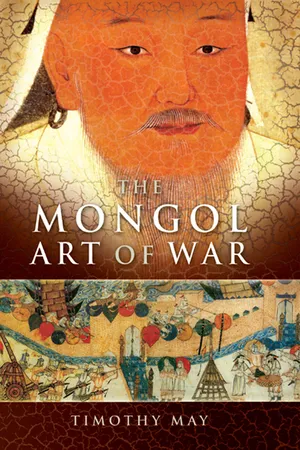

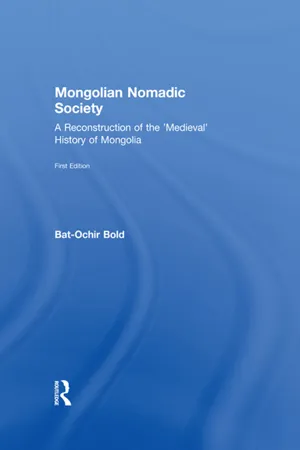
![Great Commanders [Illustrated Edition]](https://img.perlego.com/book-covers/3018137/9781782894469_300_450.webp)
